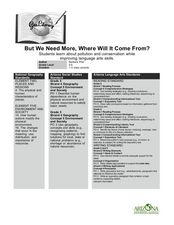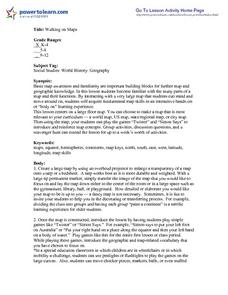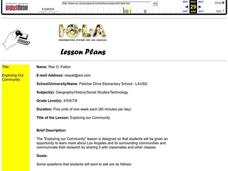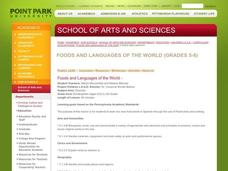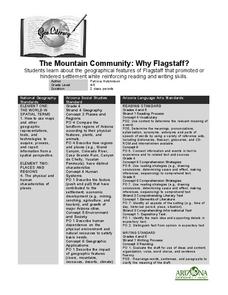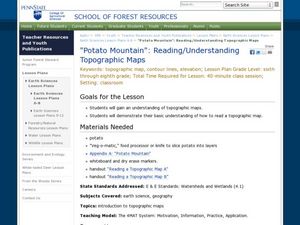Curated OER
Awesome Animals
Young scholars collect data from classmates about their favorite animal. They use the ClarisWorks graphing program to enter data, graph results, and interpret data.
Curated OER
Trade in the Global Village
Pupils use the internet to research the trade status and needs of a country of their choice. Using this information, they determine which three main products their nation needs to import and which ones they can export. They write a...
Curated OER
Hello Mexico City
Students research and explain the functions, characteristics, and cultural aspects of Mexico City and analyze how they have affected development and settlement. Students work in groups to gather information and report back to the class.
Curated OER
Thematic Unit on Cats
Students discover in which climates the cats of the world live in. They review the different climates of the world and use maps and globes to help them locate continents.
Curated OER
But We Need More, Where Will It Come From?
Students write a persuasive letter and create a poster about pollution and conservation. In this pollution and conservation lesson plan, students learn how humans are the number 1 cause of pollution.
Curated OER
A River Through Time
Learners explore how construction of a dam on the Gila River affected the lifestyle of Pima Indians. In this social studies lesson, students locate the Gila River and the Coolidge Dam. Learners record dates on a timeline and discuss how...
Curated OER
To Be Or Not To Be a State? That Is the Question
Eighth graders research Puerto Rico's culture, religion, language, government, etc. and identify differences and similarities with the United States. They participate in a debate about whether or not Puerto Rico should become a state.
Curated OER
"Pass the Potatoes" (But, where did they come from?)
Eighth graders explore various cultures around the world. In this cultural instructional activity, 8th graders prepare foods that belong to different cultures. Students examine the climate in the places of origin of their...
Curated OER
Me on the Map: Homes, Neighborhoods, and Communities
Young scholars read a book about maps and identify the differences between a picture and a map. In this maps lesson plan, students also label maps of their home, neighborhood, and community.
Curated OER
The Cold War and Development of Post-War America
Young scholars view examples of political advertisements during the years of 1952 through 1964. After viewing, they discuss how the Cold War and the threat of Communism affected the development of the United States. They compare the Cold...
Curated OER
Europe
Students examine the reasons how and why the European Union was formed. They locate Europe on a map and identify the countries in the European Union. They create a tourist brochure for one of the countries.
Curated OER
Walking on Maps
Students are introduced to the various types of maps and their functions. As a class, they play a game similar to twister to review map concepts. They answer questions about the map and use the internet to view larger maps of the world.
Curated OER
Team Teaching - Spanish
Students present a Spanish grammar topic to the class. In pairs, they select and research a grammar concept, create an over-head transparency, homework assignment, and a quiz to use with the presentation, and teach their concept to the...
Curated OER
Exploring our Community
Students research Los Angeles and its surrounding communities. They create digital presentations of the information they have gathered by answering the question included in the lesson.
Curated OER
The Oregon Trail
Students discuss migration and reasons people came across the Oregon trail. Students create a time line of important events along the Oregon trail. A Historical Time Line is included for student use. Students work in small groups to...
Curated OER
Weather in the USA
Students identify the different types of weather conditions that occur in the United States. They discover how to adapt to weather and explain forecast and warning signals.
Curated OER
iChat AV and iSight Camera
Students interact with science and math classes around the world by doing the same experiment and communicating their results. They use iChat AV and an iSight camera to share relevant information about their area, decide on the...
Curated OER
Foods and Languages of the World
Young scholars review Mexico's location and language and learn to pronouns 10 new Spanish food words. Students listen as the book, Corn is Maize is read, touching and passing around an ear of Indian corn. Young scholars discuss the...
Curated OER
Edible Coal Mining
Learners explore the concept of bituminous coal and the role it plays within our world. In this economic and earth science activity, students discover and model the extraction methods with hands-on activities. Learners also...
Curated OER
The Mountain Community: Why Flagstaff?
Students identify geographical features that hindered or promoted settlement in the city of Flagstaff, Arizona. In this settlement lesson plan, students write a summary of what they learned and identify geographical features on a map.
Curated OER
Water Issues on Puerto Rico and Oahu: A Comparison of Two Islands
Fifth graders explore how the tow islands receive and use fresh water. They also address some of the threats to the fresh water supply on each island. Students explore the lesson objectives through water cycle models and experiments.
Curated OER
"Potato Mountain": Reading/Understanding Topographic Maps
Middle schoolers investigate how to read topographic maps. In this map reading lesson students complete a topographic map activity.
Curated OER
You Too Can Haiku: How to Write a Haiku
Students explore language arts by writing their own poems. In this haiku lesson, students investigate the Japanese culture and their beautiful music, poetry and art. Students count the syllables in every line of a haiku poem and write...
Curated OER
When Am I Ever Going to Use this?
Students solve problems using equations and properties of integers. In this algebra instructional activity, students solve problems using ratio and proportion and graph their answers on a coordinate plane. They solve word problems using...




